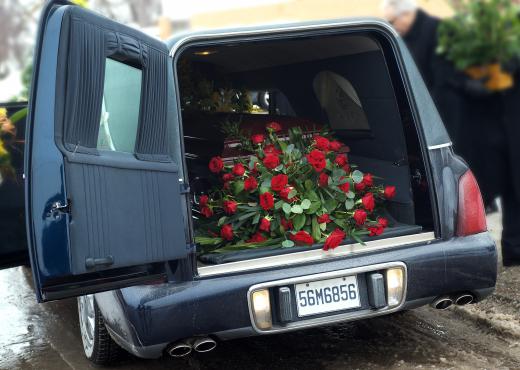At WikiMotors, we're committed to delivering accurate, trustworthy information. Our expert-authored content is rigorously fact-checked and sourced from credible authorities. Discover how we uphold the highest standards in providing you with reliable knowledge.
What is a Hearse?
A hearse is a vehicle which is designed for the transport of bodies, typically those of people. Hearses are used to transport bodies from funeral homes to funeral services, and on to cemeteries, crematoriums, or other facilities. The look of a hearse is quite distinctive, as these vehicles are designed to accommodate coffins, so they are long, narrow, and reinforced to support the weight of the car's bodywork along with the coffin, the body, and funeral home staff who accompany the body.
The term “hearse” comes from the French herce, used to describe the framework which supports candles over a bier or altar. “Hearse” has been used to describe a funerary vehicle since the 1600s, although the word is still used in some regions to refer to a framework of struts and supports, which can be a bit confusing, at times.

Obviously, the earliest hearses were horse drawn, and some hearses continue to be drawn by horses, especially for ceremonial and state funerals. Hearses tend to be highly ornamented, adding an air of ritual to an otherwise utilitarian vehicle, and they are commonly decorated with flowers, sashes, and other ornaments when they are used to transport a body. Depending on the style, a hearse may be open, allowing people to see the coffin, or closed, concealing the coffin behind solid walls or curtains.

The classic color for a hearse in the West is black, a color traditionally associated with mourning, although hearses come in other colors as well. In the East, hearses may be white or golden, and some of them are ornately decorated. In both cases, hearse manufacturers tend to use luxury vehicles as bases, with powerful engines and reinforced bodies to make sure that they withstand years of use. Because hearses can be extremely expensive, many funeral homes pool their resources to purchase one or two hearses, scheduling their use as needed.

When a funeral home arrives at a location to pick up a body, it typically uses an unmarked van, for purposes of discretion. Smaller funeral homes may use a hearse for pickups because they lack access to such a van, although this is relatively rare. Once the body has been prepared and placed in its coffin, the funeral home switches to its hearse. Depending on the type of services requested, the hearse may be used once or multiple times, to transport the body to a place of worship for services and again to a location for final disposition, such a crematorium or cemetery. Many funeral homes also keep a fleet of vehicles for the purpose of transporting mourners.
Given cultural associations with the hearse and death, it should come as no surprise to learn that these vehicles carry a certain mystique for some people. Some enthusiasts purchase decommissioned hearses for personal use because they find the thought amusing or intriguing, and it is not uncommon to see these vehicles on the road, often with peculiar decorations to differentiate them from working counterparts.
AS FEATURED ON:
AS FEATURED ON:













Discussion Comments
@boathugger -- Yes, a hearse could also serve as an ambulance. The setup in the back would be different, of course. In the ambulance type, there would be cabinets with medical supplies. Both were equipped to hold a stretcher (or gurney). Many times, employees of the funeral homes doubled as ambulance drivers, as well.
One of our local funeral homes still has one of the old hearse-ambulances. This one was primarily used as an ambulance but could substitute for a hearse if need be. It has lights on the top of it. Of course, it is just there for looks now.
Is it true that the older ambulances were actually hearses?
Post your comments